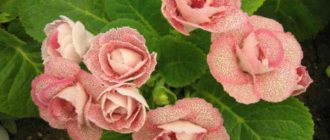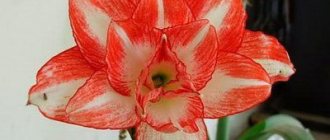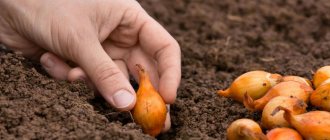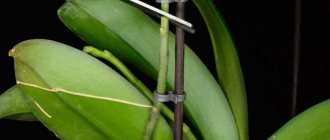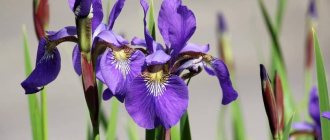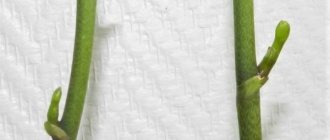The purpose of the flowering shoot
The peduncle is a temporary shoot on which the inflorescences are placed. The orchid releases an arrow after a period of rest, when it has rested and gained strength. After the peduncle appears, the flowering process begins: buds are formed, which subsequently grow, develop, and bloom (read about how to care for an orchid after it has released a peduncle). The peduncle has fulfilled its function upon completion of this stage. But you shouldn’t cut the arrow, especially if it’s healthy and green. Soon new flowers or babies may appear on it (you can find out how to grow a cake on an orchid here).
When is this phenomenon not normal?
It's okay if the orchid's peduncle starts to turn yellow after flowering. The flowers dry up and fall off, and then the arrow begins to die. We talked in detail about what to do with the peduncle after the arrow has bloomed in this material.
Things are worse when the peduncle dries out and at the same time buds form on it. Or during flowering the peduncle dries out, preventing the flowers from blooming.
In such cases, there are reasons to think about, analyze the conditions in which the orchid grows, and the rules of care.
What is the peduncle of an orchid?
This term refers to a flower shoot or arrow. It is part of the flower, which is responsible for the decorative properties of the plant. Young stems are covered with scales. It is on them that tender buds appear.
The peduncle of an orchid has certain appearance features
In appearance, these orchid fragments resemble root shoots. They are the same in shape and color, but differ in a more complex structure. At the initial stage of development, shoots can take on quite bizarre shapes. However, they then level out and continue to develop straight. Sometimes the shoot is not directed straight up, but in the other direction.
Reasons for appearance
Many people are interested in how the peduncle of an orchid appears. If the previous stem was cut not to the base, but to a dormant bud, with the arrival of autumn it will form a peduncle. After 1.5 months, flowers will appear on the plant. The beginning of flowering can be expected by the appearance of an arrow. When favorable conditions are created, its height reaches 80-100 cm.
The formation of this part of the plant indicates the beginning of the flowering process. First, buds form. Then they grow and open. The flower shoot takes part in the formation of inflorescences and contributes to their saturation with moisture and beneficial elements.
The average flowering time is 3 months. The flower arrow performs reproductive functions. With proper care, babies can form on the peduncle. After the buds fade, their germination begins. They stay on the peduncle until they are formed.
Important! When a baby develops 2 leaves and 3-4 roots, it needs to be cut off. This is required for independent growth.
What does it look like
A sign of the formation of a flower shoot is the appearance of a growing green bud in the axil. It has a sharp end. A growing shoot indicates that the orchid is at the stage of active development.
At this moment, it needs to be fed with fertilizers in order to achieve full development of the shoot. It is worth considering that any fertilizing should be applied only after watering.
How many flower stalks can there be?
A flower cannot form more than 3 such shoots. Often one stem with flowers is formed. 2-3 peduncles appear when there are 8-10 leaves in the rosette. In this case, the plant experiences some stress. Often, during the period of active flowering, the immunity of a crop decreases.
Why does this happen?
As it turned out, the peduncle can dry out not only during natural processes, but also under the influence of a number of factors.
Incorrect lighting
Orchid is a shade-tolerant plant, but this does not mean that they absolutely do not need sunlight. As a result of lack of lighting, flower stalks, leaves, aerial roots, and completely unformed buds dry out. In the absence of light, the process of photosynthesis slows down.
However, intense, bright lighting is usually harmful to the plant. The scorching rays of the sun can cause thermal burns. In summer, it is better to place the flower pot in partial shade.
Over- or under-nutrition
Quite frequent use of mineral fertilizers does more harm than good. This process is reflected in this way: the leaves, peduncle, roots dry, and the buds fall off during the flowering period. On the other hand, lack of nutrients negatively affects the development of the plant. Everything should be in moderation, and the dosage is strictly according to the instructions.
Air humidity
High or low humidity in the room is a consequence of a fading, soft peduncle. The overall tone of the plant deteriorates and unopened flowers fall off. The development of rotting processes is possible.
Hypothermia
Wilting of flower stalks occurs as a result of cold air entering the leaves. For example, when transporting a plant from a store to home, when the foliage comes into contact with glass, when it is -16ºC outside the window. It is very dangerous to ventilate the room if the orchid has just finished taking water treatments. Hypothermia provokes the release of buds, a significant deterioration in the general condition.
Overheating of roots
Orchids come from the tropics, so it’s not surprising that they love warmth. However, everything is good in moderation. Do not leave the plant in direct sunlight, near a heating radiator in winter, or under hot air from an air conditioner.
Stress
A sudden change of residence for orchids is a bit of a shock. After all, at the same time, lighting, temperature, and air humidity change. And the plant immediately reacts to such changes. At first, the flower may stop blooming and shed its buds, but then everything will get better. It takes time to adapt.
Care before and after flowering
Peony diseases: methods of treating diseases, prevention and pest control
Before the peduncle appears on the plant, you must follow these recommendations:
- provide sufficient but diffuse lighting. The bush should not be placed on the south side of the premises;
- systematically water the crop. It is recommended to do this when the top layer of soil dries;
- Place the container with the plant in a well-ventilated area. However, it should not be exposed to drafts;
- systematically feed the plant with complex fertilizers.
The orchid needs to be fed in a timely manner
When a flower arrow appears, the conditions for keeping the flower need to be slightly changed. To do this you should change:
- Location. When a flower stalk appears in mid-autumn, winter or spring, it is worth placing the container with the pot on the southern windowsill. During these periods, the sun is not so hot, so it does not harm the culture.
- Watering mode. The amount of moisture is slightly reduced. In this case, it is worth focusing on the conditions of the culture. Sometimes you have to water the plant at intervals of 2 weeks.
- Fertilizer application. When the flower arrow appears, slightly reduce the amount and frequency of use of fertilizing. When the flower gets stronger and grows, and swelling buds begin to form, fertilization is stopped.
Important! The abundance of fertilizers does not in any way affect the number of flower buds. Their number is determined at the stage of peduncle formation.
Is it possible to cut off the peduncle?
Cutting off a green shoot that is growing is strictly prohibited. Even if a fragment from above is lost, it can continue to grow and bloom from a waiting bud. After flowering ends, the green and living part of the peduncle is also left on the bush. Subsequently, it will be able to continue flowering. There is also a possibility of babies appearing from waiting buds.
The peduncle near the trunk should be completely removed only when it is completely dry and changes color.
Important! If after pruning it turns out that the shoot is hollow inside, it should be treated with garden varnish. This will help prevent water from getting inside.
How to secure
In order for the plant to look attractive, the stem should be secured. Otherwise it may break. When carrying out the procedure, you should follow these rules:
- Tie the bush vertically when it reaches a height of 20 cm.
- Attach the arrow to the support using an elastic band or a special clothespin.
- Rotate the flower pot. Thanks to this, the shoot will be able to reach towards the light and straighten up.
When should you trim the arrow?
The ideal time for trimming a dry peduncle is the dormant period, then you can be sure that the orchid is resting and will not bloom yet. But this period of time occurs differently for different varieties, in most cases it is mid or late autumn.
Despite the time frame, you can cut off flower stalks only after they have completely dried out, so that not a single living bud remains. If we cut “to the quick,” in this case we will harm the plant and weaken it. All energy will be spent on healing wounds.
Types of peduncle damage
May be interesting Decembrist - care features Aspidistra flower: growing and care at home, what to fertilize, photo Poinsettia: growing, care and propagation at home
Before starting measures to restore the flower, assess the degree of its damage:
- If the peduncle of a phalaenopsis or other orchid breaks in the middle, then this will not cause much harm to the flower. The remaining lower part of the stem contains live flower buds. They soon bloom without further stimulation.
- If the entire peduncle breaks off, but a living bud remains near the base, it gives rise to a new arrow. It usually grows thin and short and produces smaller flowers.
- When a broken arrow completely dries out, the plant can be restored only after lengthy resuscitation measures.
Important!
How successful recovery will be depends on the nature of the damage and the age of the plant. Young specimens recover easily and quickly. The old ones take the damage very hard.
In order for the rehabilitation to be successful, the flower is provided with increased temperature and humidity in the room and long daylight hours. The affected plant is protected from insect attacks and possible diseases.
Do you need a transplant?
The cause of sudden drying of the peduncle is waterlogging. It is worth carefully examining the roots to see what condition they are in. Green - healthy, light with a silver tint - the orchid is resting, brown, black color indicates the presence of rot or other diseases. Then, you can’t do without a transplant.
Measures taken:
- Remove the flower from the pot.
- Rinse the roots under running water.
- Remove damaged areas and treat sections with an antiseptic.
- Leave to dry overnight.
- Replant the orchid in new soil with a good drainage layer.
- At first, it is better to postpone watering and spray with warm, soft water.
- It is recommended to place the flowerpot in a dark place for better adaptation.
What to do with a dried shoot?
If the peduncle is still green and the tip has begun to turn yellow, there is no need to remove it. For a visually attractive look, you can cut off the dry tip. We remove the entire dry peduncle, which will give strength to restore the orchid.
For the elimination process you will need pruning shears or a sharp knife. Disinfect all instruments in advance.
- Carefully trim off any dry parts of the plant.
- The stump should remain no more than 2 cm.
- Sprinkle the live cut with an antiseptic.
- If there are dry leaves and roots, remove them in the same way.
- Do not water the flower for 7-10 days, let it recover.
How to care
Let's consider the features of caring for an orchid and its maintenance after flowering.
Lighting
In winter, there is not enough natural light in our area. Therefore, in order for the orchid to feel normal and be able to recover well during the dormant period, it needs additional lighting. If the plant does not have enough light, its leaves will stretch out, turn pale, and the next growing season will be in big doubt.
The artificial lamp should be placed at a height of 20-30 cm from the flower. Do not use a lamp that is too powerful: 60 W will be enough.
Temperature
Hypothermia of a delicate flower should not be allowed. If the pot is on the floor, place a stand under it, if on the windowsill, make sure that the flower is not close to the window,
Humidity and watering
During the dormant period, the orchid's need for moisture is significantly reduced. Watering should be reduced and the soil should be moistened only as it dries. The standard frequency of watering at this time is once every 10 days. It is not worth spraying the orchid in the cool season, as the procedure can lead to rotting of the vegetative part of the plant.
Top dressing
During the dormant period, the orchid is fed rarely - no more than once a month, or even less often. The fact is that in winter the plant absorbs the applied fertilizers much more slowly, since the metabolism in its tissues is inhibited.
Important: if the plant needs replanting, it is best to carry out the procedure immediately after flowering.
Aftercare of the plant
In order to avoid negative consequences of the operation, it is best not to touch the orchid for a while, but try to comply with the following conditions:
- The flower loves temperatures in summer: +22-25ºС, in winter +16-18ºС. However, for the first few weeks after removing the peduncle, it is better to lower the temperature to +20-22°C.
- Minimize watering, but make sure the soil in the pot dries out.
- Avoid intense lighting. Limit the duration of exposure to light.
- Maintain humidity within 50-60%.
- Do not allow air to stagnate in the room.
- Do not feed for the first month, and then once every 30 days.
- For orchids, it is recommended to update the substrate every 2-3 years, and this is best done in the period after flowering.
- The water temperature should be 35-40ºС.
- Spray regularly.
As it turned out, pruning is not such a terrible thing. The main thing is to analyze the condition of the flower, read the recommendations, prepare everything, and you can start. Attention and care are needed not only by people, but also by beautiful representatives of the flora. They will reciprocate you with long and lush flowering.
There are often situations when a healthy, well-groomed plant produces new leaves, but refuses to bloom. We recommend that you look at materials from our experts about why an orchid does not produce a peduncle and how to force it to do so, as well as how to distinguish the root from the peduncle.
Lighting
The problem of insufficient lighting is acute for the gardener with the arrival of autumn: the duration of daylight hours becomes shorter, but the plant, as before, urgently needs sunlight, otherwise it will simply die. In such conditions, an arrow may appear on the orchid, but buds are unlikely to form. And after a short time, the peduncle itself will dry out.
In an effort to improve the condition of an orchid, many gardeners make the common mistake of regularly turning the pot relative to the light source. For representatives of the Orchid family, such manipulations are equivalent to extreme stress; they may behave completely differently than you expect, including getting rid of the peduncle.

